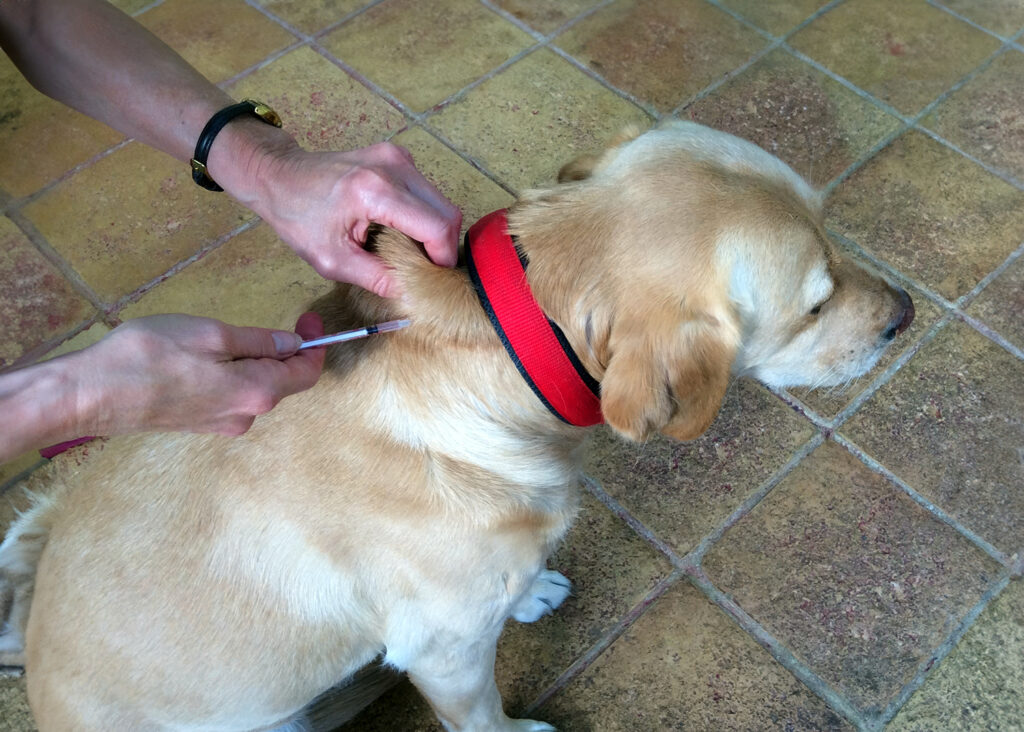Understanding Diabetes in Dogs: Symptoms and Management Tips
 Dog being given a subcutaneous insulin injection.
Dog being given a subcutaneous insulin injection.Did you know that diabetes doesn’t just affect humans? In fact Diabetes Mellitus, to give it its full name, is one of the most common endocrine conditions seen in dogs. The term endocrine relates to glands whose secretions (hormones) flow directly into the blood stream.
This is not a definitive guide but provides an overview of Diabetes Mellitus, helping the reader gain a better understanding of what causes the disease, the effect it has on a dog and how to manage it.
What is Diabetes Mellitus?
Diabetes Mellitus is a complex condition caused by resistance to, a deficiency or a complete lack of a hormone called insulin. Insulin, released by the pancreas near the stomach, regulates glucose levels by breaking down carbohydrates, fats, and proteins.
Insufficient insulin production or utilisation leads to hyperglycemia, where blood sugar levels surge. Left untreated, hyperglycemia can trigger severe health issues. While the precise cause of diabetes remains unclear, factors such as autoimmune disorders, obesity, pancreatitis, tumors, and prolonged glucocorticoid use contribute to its development.
Which Dogs are Most Prone to Diabetes?
It’s more usual to see diabetes in middle-aged dogs and certain breeds including Poodles, Terriers, Schnauzers and Dachshunds seem to be over represented. Bitches that haven’t been spayed are at greater risk because of the presence of the female hormone progesterone. However, the condition can occur at any age and in any breed or sex of dog.
Classification of Diabetes Mellitus
As in humans, this condition can be divided into two types. Type I (lack of insulin production) and Type II (insulin resistance).
Type I (insulin dependent diabetes) is the most common form in dogs and ultimately, in order to survive, they require insulin therapy.
Signs and Symptoms
Evidence of any of the following symptoms should be reported to your veterinary surgeon immediately.
- Excessive thirst
- Increased urination
- Changes to normal eating patterns (increased hunger or lack of appetite)
- Lethargy and lack of energy
- Changes in weight
- Urinary tract infection
- Development of cataracts
- Vomiting and dehydration
- A sweet smelling breath (Ketoacidosis)
How is Diabetes Diagnosed?
The diagnosis is based on evidence of the clinical symptoms and includes the following veterinary investigations:
- Urinalysis (checking for the presence of glucose in the urine).
- Fasting blood tests showing a persistently elevated blood glucose level.
- Assessing water intake over a 24 hour period.
Treatment and Management
It is extremely unusual for a dog to respond to oral medication and most cases require a combination of injectable insulin and strict dietary management. Most dogs require one insulin injection per day although some benefit from twice daily injections.
The aim of the treatment is to address and correct any of the symptoms and restore the blood glucose level to as near normal as possible. The main objective is to prevent the blood glucose levels swinging too high or too low.
Dogs that are seriously ill will be hospitalised and receive intensive care until they have been stabilised. Entire bitches should be spayed.
Once a dog’s individual insulin dose has been established they will be allowed home and owners will be taught how to administer injections and given detailed management instructions.
Owners will usually be asked to keep a note of their dog’s daily routine and to carry out the following tasks regularly:
- Take urine glucose values each day and/or measure and record blood glucose levels (using simple home test kits)
- Record the amount of insulin injected
- Record the amount and time of feeding
- Assess bodyweight
Pre-printed assessment sheets are usually provided by the veterinary surgeon to help owners.
Diet
Dietary management plays an essential role in the treatment of Diabetes Mellitus. It is important that the main meal coincides with peak circulating insulin levels so feeding the exact amounts in conjunction with insulin injections is crucial. A high fibre diet with complex carbohydrates helps to prevent fluctuations in blood glucose levels and controls obesity. Feeding the correct composition of fats and proteins is also important. For these reasons a prescription diet, specifically designed for diabetics should be used rather than a general proprietary brand. Avoid treats, especially those that are high in glucose.
Diabetics should have free access to a fresh supply of clean water at all times.
Exercise
Exercise is important in maintaining blood glucose levels and helps with weight loss. It also enhances the mobilisation of insulin. However, the amount and timing of exercise should be consistent and must not vary from day to day.
What is Hypoglycaemia?
If too high a dose of insulin is given or if the dog fails to eat after its injection, then there is a risk of it becoming hypoglycaemic. This is when the level of glucose in the bloodstream is too low.
The signs of hypoglycaemia include:
- Lethargy
- Muscle tremors
- Weakness
- Collapse
- Diabetic coma and death
What is the first aid treatment for hypoglycaemia?
- At the first signs administer a glucose rich solution such as honey or glucose and water by mouth. If using a syringe ensure that you do this slowly, giving the dog time to swallow
- DO NOT administer any oral solutions if the dog is collapsed or unconscious
- In the above circumstances the dog must be taken to the veterinary surgery as soon as possible where it will be placed on an intravenous infusion of glucose and closely monitored
Do dogs with Diabetes Mellitus have a good quality of life?
The good news is that, provided the condition is quickly diagnosed and the dog has been stabilised, the majority of dogs respond well to treatment. With the appropriate care and management most go on to have a good quality of life.